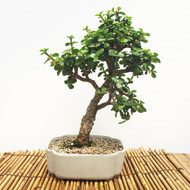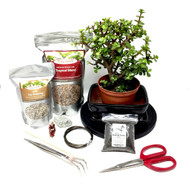General Background:
Originating in the dry regions of South Africa, the Dwarf Jade, or ‘Elephant Bush’, is a succulent plant, which explains its ability to store water for a long time. It is a very undemanding plant, well suited for individuals who travel often or who are prone to forget to water their plants. Though it grows to heights of 10 feet tall in its native habitat, it is an ideal bonsai for a beginner; this beautiful plant is easy to care for and will be a thing of beauty for years to come.
Trees Features:
Thick, round, dark green leaves and delicate pink flowers sit atop fleshy stems and branches. These succulent features hold water for long periods of time.
Temperature:
In the winter it can tolerate 50-61 degrees but will be fine between 61 and 71 degrees. Freezing temperatures will destroy this succulent plant. It will do well indoors throughout the year, but will be happiest if it gets to enjoy the outdoors during the summer.
Lighting:
Can be kept indoors near a bright window, but does love fresh air, so after the last frost of the season, it will enjoy being outside in a spot where it will receive full sunlight which will encourage the leaves to remain small and compact. It can tolerate partial sunlight.
Watering:
The Dwarf Jade needs to be watered only after the soil is quite dry as it needs very little water. In the winter, if it is placed in a cool location, it will only need water every four to eight weeks. This plant can go without water for upward of four weeks without suffering at all making this easy to care for plant a gem for busy people.
Fertilizing:
Do not fertilize during the winter months as it only likes to be fertilized in the spring and summer every four weeks with a liquid bonsai fertilizer.
Pruning / Training:
Shaping is easy with this plant, again making it ideal for beginners. Established branches can be pruned from early spring to summer, and new shoots can be pruned anytime. Near the end of the summer, cut back 1 or 2 pairs of leaves after 4 or 5 leaf pairs have developed. Remove shoots that grow directly on the trunk, or branches that develop inside the crown. Because the bark is sensitive, branches can break easily so if you do choose to wire this plant, be sure to proceed gently and carefully during mid or late summer. You can encourage the direction of plant growth by manipulating the location of light as it will reach out for light.
Insects / Pests:
Keeping the leaves on your bonsai will go a long way in keeping it healthy. Overzealous watering is the biggest problem found in this hearty plant. Do not over water or your plant will develop root rot and will die. If you notice any abnormal leaf drop, stickiness to the foliage, or visible insects, you need to treat the problem promptly. Start by spraying your bonsai with a solution of 1 tsp dish soap to 1 quart tepid water or Neem oil spray and spray till mixture runs off the leaves; Rinse solution off leaves with plain water and repeat every few days as needed.
Propagation:
Take 2 ½ to 6 inch cuttings and let them dry out for 2 weeks; then, plant them in a dry peat moss-sand mix and do not water. Water sparingly only after new root fibers have developed.
Repotting:
Repotting will be desired ever two years in the late spring, pruning the roots. The dwarf jade will want to be repotted with sandy-loam as it needs very good drainage.
Additional Comments:
Sometimes referred to as the “money plant”, South Africans have a saying: “as long as your Spekboom (Elephant Bush) grows and prospers, so will your finances.” Fortunately, this branching bonsai will thrive to a ripe old age with very little care. This lovely succulent is an important source of food and moisture in the wild because elephants, sheep, goats and other creatures munch their way through its dense thickets.
DISCLAIMER: The content provided in this article is not warranted or guaranteed by Bonsai Outlet. The content provided is intended for entertainment and/or educational purposes in order to introduce to the reader key ideas, concepts, and/or product reviews. We are not liable for any negative consequences that may result from implementing any information covered in our articles or tutorials. Happy bonsai gardening.








